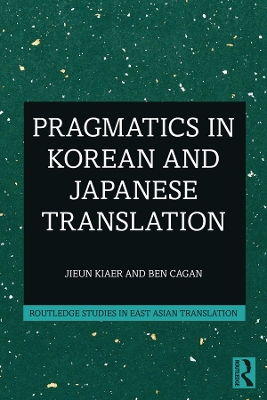Routledge Studies in East Asian Translation
2 total works
Korean Wave in World Englishes
by Brittany Khedun-Burgoine and Jieun Kiaer
This book examines the linguistic impact of the Korean Wave on World Englishes, demonstrating that the K-Wave is not only a phenomenon of popular culture, but also language.
The 'Korean Wave' is a neologism that was coined during the 1990s which includes K-pop, K-dramas, K-film, K-food, and K-beauty, and in recent years, it has peaked in global popularity. The book intends to show how social media phenomena has facilitated the growth of Korea's cultural influence globally and has enabled a number of Korean origin words to settle in varieties of Englishes, which in turn has globalised Korean origin words and revolutionised the English language through an active and collaborative process of lexical migration. Korean origin words such as oppa 'older brother', are no longer bound solely to Korean-speaking contexts. The study focuses primarily on media content, particularly social media, corroborated by case studies to examine how linguistic innovation has been engendered by the Korean Wave.
Suitable for students and researchers of Korean linguistics, Korean culture, Korean popular culture and translation studies, this book is the first detailed study of the global linguistic impact of the Korean Wave.
Pragmatics in Korean and Japanese Translation
by Jieun Kiaer and Ben Cagan
This book explores how the greater amount of pragmatic information encoded in Korean and Japanese can result in pragmatic (in)visibility when translating between those languages and English. Pragmatic information must be added when translating from English to Korean or Japanese and is easily lost when translating in the other direction.
This book offers an analysis of translations in Japanese and Korean of Harry Potter and the Philosopher’s Stone, and The Hobbit, or There and Back Again, to show how the translated versions crystallise the translators’ interpretations of relationships in the way characters address one another. This book discusses fan translations of Korean and Japanese to English of various popular media, observing that the emotional meanings easily lost when translating in this direction are often deemed important enough to warrant the insertion of additional explanatory material. The book additionally discusses the role of fan translation in the construction of international online communities and a heightened communal commentary on translation. Western translation commentary has historically lacked sufficient emphasis on translation to and from East Asian languages, and these case studies help to address a problem of central importance to translation to and from languages that encode interpersonal dynamics in dramatically different ways to English.
This book will be of interest to students and researchers in translation studies, particularly in Korean and Japanese translation. The book will also appeal to students and researchers of the Korean and Japanese languages.

